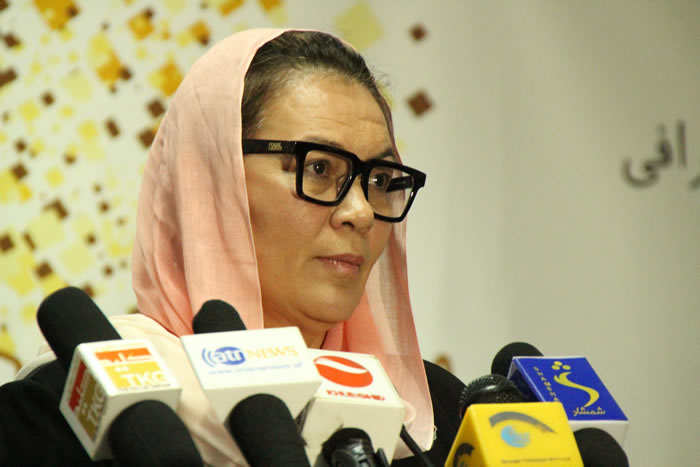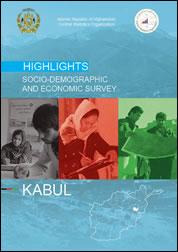Kabul, 13 January 2015 - Central Statistics Organization of Afghanistan launched the highlights of Kabul Socio-Demographic and Economic Survey this morning during a press event. In addition to the CSO leadership, other relevant government entities, Kabul governor, Head of Kabul Municipality, Kabul districts administrators, representatives from United Nations, and international organizations also participated in the event.
Central Statistics Organization, with the support of other government entities and the people of Kabul conducted the SDES in Kabul, as the fourth province that was covered with the technical and programming support of United Nations Population Fund (UNFPA).
The SDES is designed as a long term project to gradually gather information on population from all 34 provinces. This survey also builds CSO staff capacity in conducting large scale surveys. SDES is going to provide village level data for local development policy and planning.

THE MAIN OBJECTIVES OF THE SURVEY ARE:
- Gathering data for evidence based decision making, policy, planning and management,
- Providing data for business and industries,
- Providing policy and planning for residence housing,
- Providing data about vulnerable populations,
- Providing data for the basis of humanitarian assistance, and
- Availability of data for research and analysis,
The SDES is conducted in a way that it covers 50 percent of all households in a given area with survey questionnaires and the remaining 50 percent of the households are asked the name of the head of the household and the number of members of the household by sex during the listing.
SDES GATHERED INFORMATION AS:
- Age, gender, education, literacy, employment issue, people on jobs, fertility, mortality, birth registration, parents' living status, housing characteristics (some of the indicators gathered are similar to those gathered in a census).
- One of the major differences of the SDES with other surveys is that data for the SDES is gathered at the village level.
SDES was conducted in 16 Nahia and 14 districts of Kabul covering 3068 enumeration areas by 2690 surveyors. The data was entered into databases by 344 data entry staff and 178 people edited and data.
Some findings of Socio-demographic and Economic Survey include:
- Of the total population of Kabul 51.6% is male and 48.4% is female. Kabul provincial Capital comprises 77.2 percent of the total population of Kabul province.
- Children between 5 - 9 years old comprised the biggest age group among all the age groups in Kabul while youth (aged 15- 24) comprised 23.2% of the total population of Kabul. There were 100 women for every 106 men. Population density is 7907 people in one square kilometer, which is the highest in the country.
- Literacy rate for people aged 15 and above is 55.2%, while among youth between the ages of 15-24, it is 70.7%. Literacy rate among the population 10 years old and above is 59.6%.
- Net attendance rate in high school in Kabul was 39.1%. Birth registration rate in Kabul is highest at 66%, in comparison to nationwide 35.2%.
- Around 1.7 percent of the Kabul population 5 years or older at the time of the survey had at least one functional difficulty in seeing, hearing, walking, remembering, communicating, or self-caring.
- Percentage of population with economic activities was at 35.1, which means they were engaged in economic activities in the last six months and more.
- 64.1% of the population was not engaged in economic activites for the past 12 months before the survey.
- Among the population not engaged in economic activities 64.4% were more busy at home (64.4%) and 26.6 percent were busy studying in a university.
- In Kabul province among married women aged 15 or above, 9 out of ten (91.1%) had given birth.
- Surobi district had the highest ratio of married women (90.8%) between the ages of 15-49 who had given birth.
- Mortality in the past three years before the survey was 42,000 deaths, where mortality was higher for men (57.6%) than for women (42.4%).
- Newborn mortality 2 years before the survey comprised 12.9% of the total 42,000 deaths where male infants made the higher number of infants deaths 57.6% than female infants (42.4%).
- One in every 5 deaths (18.8%) in the past 2 years were children below the ages of 5.
- Average household size in Kabul was 6.9 people.
- LPG was the main source of energy (81.5%) for cooking in the households.
- One in every four households in Kabul owned some agricultural land.
- 92.6% of households in Kabul had access to city power in their houses.
- Two in five households in Kabul Province reported to be having an improved sanitation toilet facility. Three in every 4 households in Kabul had access to improved water resources.
- 22.8% of households were living in rented houses.
Central Statistics Organization of Afghanistan would like to thank the people of Kabul who took part in successfully conducting the survey and hopes that policy makers and planners will use the findings of this survey to improve the lives of the population in Kabul.

Download: [ENGLISH]
Press Relase:
For more information:
Central Statistics Organization of Afghanistan
Phone: 0202104338 / 0202104093 / 0202104095


